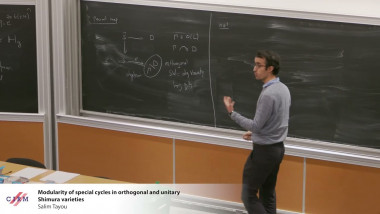![[1242] Réfutation de la conjecture du télescope de Ravenel](/media/cache/video_light/uploads/video/SeminaireBourbaki.jpg)
[1242] Réfutation de la conjecture du télescope de Ravenel
De Christian Ausoni

Modularity of special cycles in orthogonal and unitary Shimura varieties
De Salim Tayou
De Ivan Panin
Apparaît dans la collection : Ivan Panin - A Local Construction of Stable Motivic Homotopy Theory
V. Voevodsky [6] invented the category of framed correspondences with the hope to give a new construction of stable motivic homotopy theory $SH(k)$ which will be more friendly for computational purposes. Joint with G. Garkusha we used framed correspondences to develop the theory of framed motives in [4]. This theory led us in [5] to a genuinely local construction of $SH(k)$. In particular, we get rid of motivic equivalences completely.
In my lectures I will recall the definition of framed correspondences and describe the genuinely local model for $SH(k)$ (assuming that the base field $k$ is infinite and perfect). I will also discuss several applications. Let $Fr(Y,X)$ be the pointed set of stable framed correspondences between smooth algebraic varieties $Y$ and $X$. For the first two applications I choose $k = \mathbb C$ for simplicity. For further two applications $k$ is any infinite and perfect field.
(1) The simplicial space $Fr(\Delta_{alg},S^1)$ has the homotopy type of the topological space $\Omega^\infty\Sigma^\infty(S^1_{top})$. So the topological space $\Omega^\infty_{S^1}\Sigma^\infty_{S^1}(S^1_{top})$ is recovered as the simplicial set $Fr(\Delta_{alg},S^1)$, which is described in terms of algebraic varieties only. This is one of the computational miracles of framed correspondences.
(2) The assignment $X\mapsto \pi(Fr(\Delta_{alg},X\otimes S^1))$ is a homology theory on complex algebraic varieties. Moreover, this homology theory regarded with $\mathbb Z/n$-coefficients coincides with the stable homotopies $X\mapsto\pi^S_*(X_+\wedge S^1_{top};\mathbb Z/n)$ with $\mathbb Z/n$-coefficients. The latter result is an extension of the celebrated Suslin–Voevodsky theorem on motivic homology of weight zero to the stable motivic homotopy context.
(3) Another application of the theory is as follows. It turns out that $\pi^s_{0,0}(X_+) = H_0(\mathbb Z F(\Delta,X))$, where $(\mathbb Z F(\Delta,X))$ is the chain complex of stable linear framed correspondences introduced in [4]. For $X = \mathbb G_m^n$ this homology group was computed by A. Neshitov as the nth Milnor–Witt group $K_n^{MW} (k)$ of the base field $k$ recovering the celebrated theorem of Morel.
(4) As a consequence of the theory of framed motives, the canonical morphism of motivic spaces can : $C_\star Fr(X) \rightarrow \Omega^\infty_{\mathbb P^1}\Sigma^\infty_{\mathbb P^1}(X_+)$ is Nisnich locally a group completion for any smooth simplicial scheme $X$. In particular, if $C_\star Fr(X)$ is Nisnevich locally connected, then the morphism can is a Nisnevich local weak equivalence. Thus in this case $C_\star Fr(X)$ is an infinite motivic loop space and $\pi_n(C_\star Fr(X)(K)) = \pi^{A_1}_{n,0} (\Sigma^\infty_{\mathbb P^1} (X_+))(K)$.
